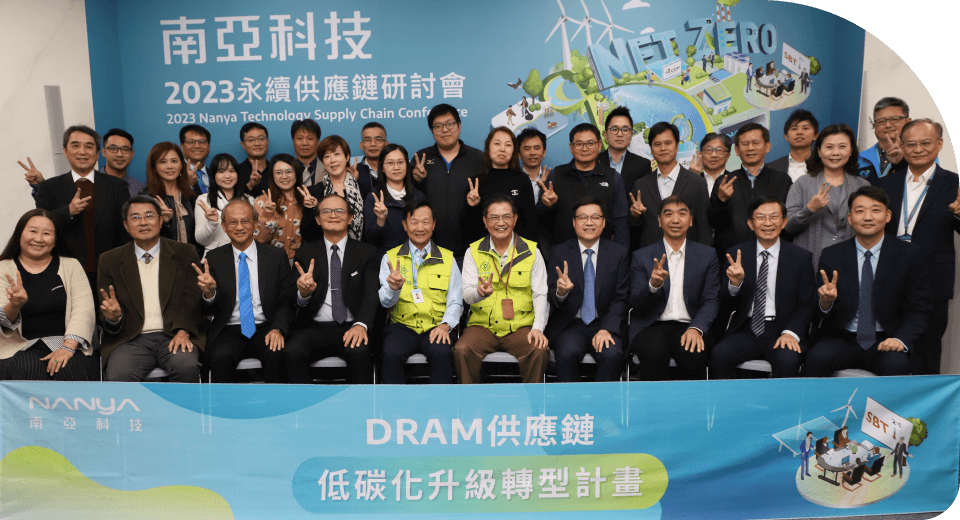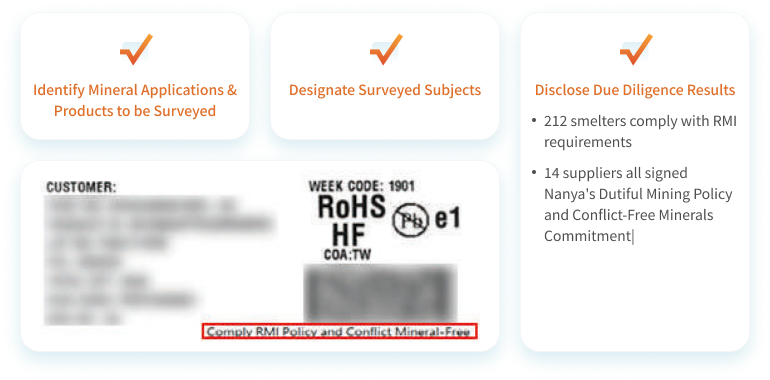PROCUREMENT
Responsible Procurement A Promoter of Shared Value
Suppliers have always been Nanya's most important business partners. We aim to enhance cooperation to create greater value and share the value and benefits of cooperation and create a sustainable future.

- Completion of SAQ by significant suppliers 100 %
- Refunds 3,781 migrant contractors 2023 Cumulative amount 97.05 million
- RMI-approved smelters identified in supply chain survey 203 contractors
Strategy and Performance of Material Topics
 Sustainable Supply Chain Management
Sustainable Supply Chain Management
Sustainable Supply Chain Management Strategy
Nanya's selection criteria for direct material suppliers not only require passing third-party verification of ISO 9001 and ISO 14001, need to be evaluated rigorously. We review our suppliers through supplier evaluation management system based on six aspects: quality, delivery, service, cost, technology, and sustainability. The score for sustainable management indicators (sustainable operations) accounts for 19% to ensure compliance with the Company's requirements for sustainable supplier management. After becoming the Company's supplier, the implementation of supplier sustainability management is verified through audits.
- The six most important supplier management strategies are: "quality, delivery, service, costs,technology, and sustainable development"
- Sustainable operations: Green environment evaluation items include the ISO 14001 certification, energy and resource conservation, reduction in greenhouse gas emissions, and waste recycling rate
- Sustainable operations: Corporate social responsibility evaluation items include compliance with local labor laws and regulations
-
 Sustainable Supplier Risk Management
Sustainable Supplier Risk ManagementImplement risk assessment through self-evaluation questionnaires for suppliers, and strengthen supplier risk management through audits and improvement tracking.
-
 Supplier Cooperation and Exchange
Supplier Cooperation and ExchangePeriodically organize supplier conferences and supplier evaluations on the basis of cooperation and mutual aid, and provide guidence for suppliers to increase social, economic, and environmental benefits, in order to achieve sustainable development of suppliers.
-
 Improve the Sustainability of Suppliers
Improve the Sustainability of SuppliersNanya pays attention to environmental and social sustainability issues while pursuing economic benefits, and continues to work with suppliers in projects related to sustainability.
-
 Responsible Mineral Procurement
Responsible Mineral ProcurementNanya is committed to a responsible procurement management strategy for the ban on conflict minerals to satisfy current and future market, legal, and regulatory expectations.
Sustainable Supply Chain Management Process
Nanya has established a complete supply chain management process, ensuring that suppliers meet our standards and requirements through a cycle of five major processes: sustainability specifications, active risk assessment, sustainability risk assessment questionnaire, sustainability audit/guidance and improvement, and supplier capability development. We understand the status of supply chain risks through the risk investigation and audit mechanism, and guide suppliers to make improvements and build capabilities, so as to gradually improve the supply chain's overall sustainability performance.

Supply Chain Sustainability Projects
In response to changes and updates to sustainability trends, Nanya Technology Corporation will continue to improve supplier sustainability through seminars and project guidance, which raise suppliers' awareness and ability to achieve sustainability.

 Improve the Sustainability of Supply Chains
Improve the Sustainability of Supply Chains

Group photo at the 2023 Sustainable Supply Chain Seminar
Sustainable Development Mutual Benefit Initiative
We invited over 20 suppliers, including raw materials, equipment, packaging and testing, and contracting,to participate in the "4th Sustainable Supply Chain Seminar" on December 5, 2023. The theme of the seminar was the mutual benefit of climate and nature. During the seminar, the Taiwan Institute for Sustainable Energy was invited to share "Net Zero ESG Development Trends," National Taipei University of Technology shared "Why Nature and Biodiversity Matters - TNFD Trend Analysis," and the Green Energy & Environment Research Laboratories of the ITRI shared "Digital Carbon Management and Carbon Reduction Hotspot Analysis Technology," sharing new carbon reduction technologies and management measures. Vice President Joseph Wu of Nanya shared sustainable supply chain management strategies and future directions for cooperation. We hope that the seminar will raise the sustainability awareness of Nanya and our suppliers, and to stay up-to-date on the latest announcements, laws, and international standards, jointly facing future sustainable development trends. In addition, all suppliers were invited to an exchange after the seminar, in which Nanya's benchmark suppliers shared their own sustainability management methods and performance, and how they responded to international trends and the requirements of stakeholders. Nanya shares its resources through public events, and will continue to exert influence with its suppliers to enhance the sustainability resilience of the entire value chain.
 Responsible Mineral Procurement Management
Responsible Mineral Procurement Management
Nanya Technology is committed to the management of conflict-free minerals and responsible procurement strategies. We publish responsible mineral procurement policies to meet current and future market, legal and regulatory expectations. In order to comply with the requirements of conflict-free metals and to bear the responsibilities of the Responsible Business Alliance (RBA). Also fullfill the goals of the Responsible Minerals Assurance Process (RMAP). Starting in 2022, Nanya Technology has added the statement "Comply with RMI Policy and Conflict Mineral-Free" on product labels in order to declare all of our products are qualified conflict minerals free.


Result of Responsible Mineral Procurement Due Diligence
According to due diligence of the supply chain and comparison with the list of qualified smelters of the Responsible Minerals Initiative (RMI), a total of 45 suppliers use metallic minerals and 203 smelters were identified as Responsible Minerals Initiative (RMI) certified smelters, with 100% comply with the conflict-free minerals and responsible minerals policy, making real contributions to the environment and industry supply chain.


 ESG News
ESG News
 Facebook
Facebook